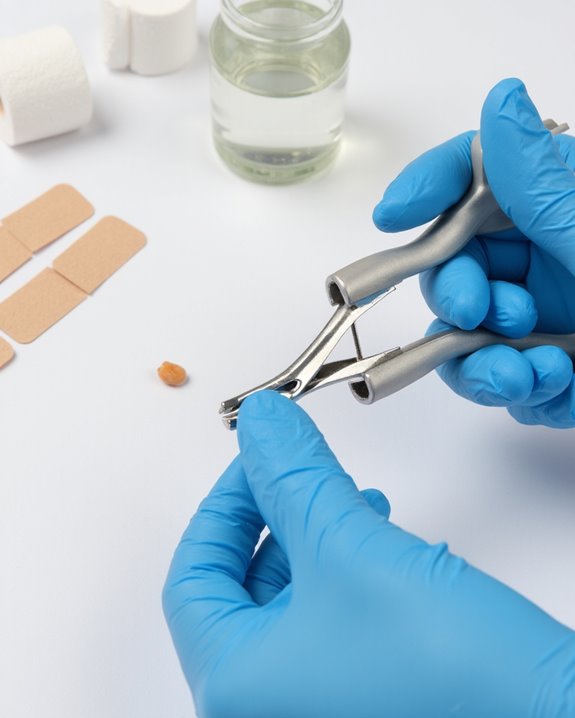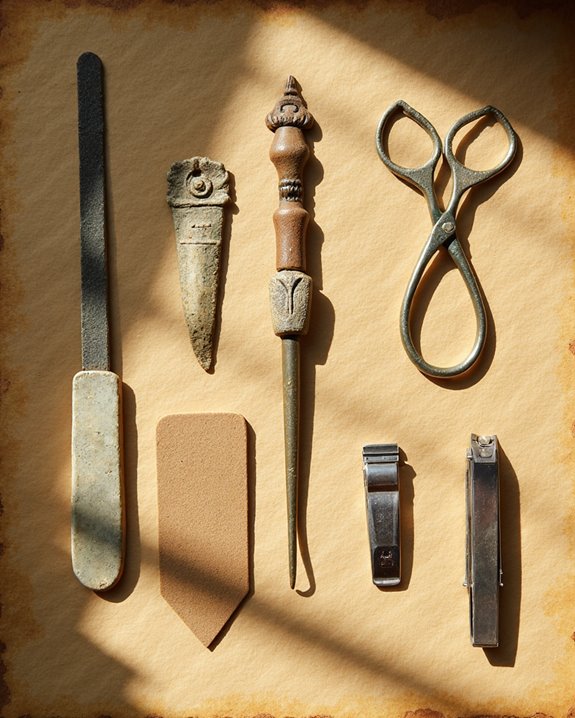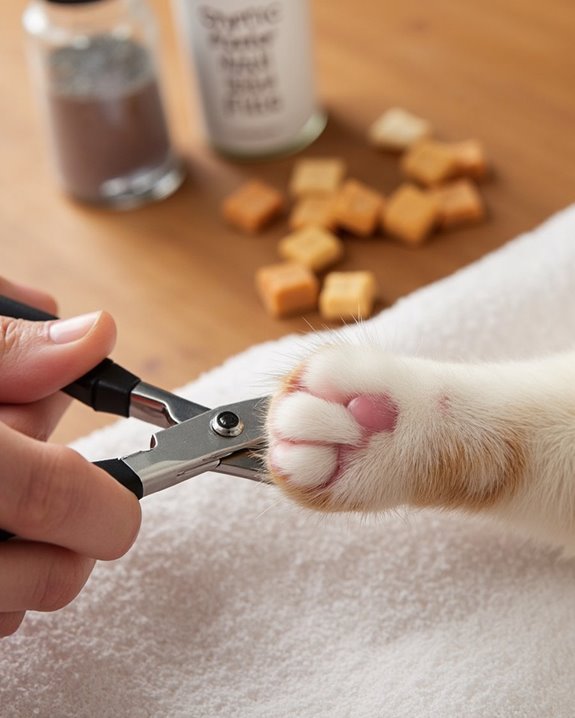Modern nail clippers were invented in the late 19th century, with Valentine Fogerty securing the first patent in 1875, followed by refinements from William Edge (1876) and Heim and Matz (1881). For nail care, I recommend trimming nails with a small white edge to protect the nail bed, filing in one direction to prevent splitting, moisturizing cuticles regularly, and cleaning underneath daily. Proper tool selection and maintenance techniques greatly impact your nail strength and appearance.
Key Takeaways
- Modern nail clippers were first patented in 1875 by Valentine Fogerty in England.
- Leave a small sliver of white tip when trimming to protect your nail bed and strengthen nails.
- File nails in one direction only to prevent splitting and maintain nail integrity.
- Clean underneath nails daily and treat cuticles gently, avoiding cutting or peeling them.
- Replace clippers when dull and consider ergonomic options with better grip for easier trimming.
Ancient Nail Trimming Before Modern Tools
How did our ancestors manage their nail care without the convenient metal clippers we’re accustomed to today? The history of fingernail trimming reveals our ingenious ancestors employed several effective methods. In ancient civilizations like Egypt and Mesopotamia, people utilized small knives or sharp stones for nail trimming, carefully paring away excess growth. I’ve found fascinating evidence in historical texts, including references in the 8th century BC Book of Deuteronomy, documenting these early nail care practices. Additionally, the use of nail trimming tools evolved over time, paving the way for the modern clippers we use today. Many ancient people simply bit their nails, a universal technique that required no tools. Others preferred filing their nails against abrasive surfaces like rocks or shells. By the Roman era, professional nail care emerged, with Horace’s writings from 20 BC describing specialized nail trimming in barber shops using dedicated cutting tools.
Early Nail Care Implements Throughout History
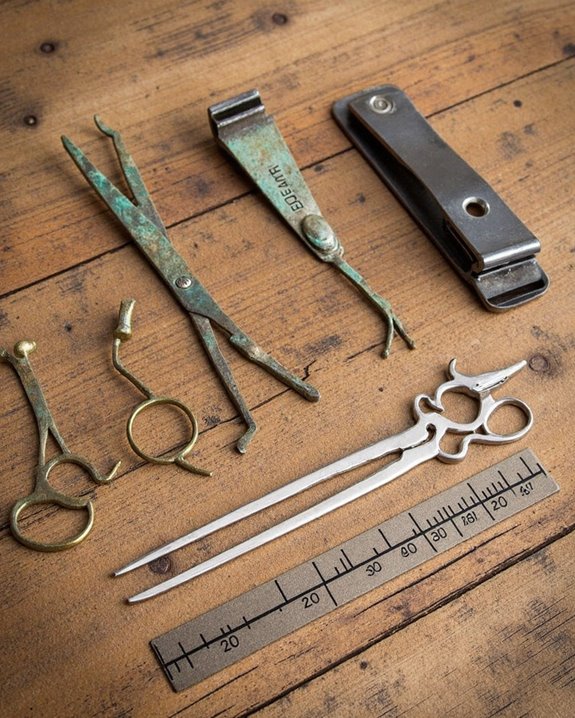
Five distinct nail care tools emerged across ancient civilizations, marking humanity’s earliest efforts at personal grooming. The history of nail clippers dates back to ancient Egypt, where small knives and sharp stones facilitated the process of nail trimming, an essential aspect of personal hygiene. The Chinese employed rudimentary implements like sharpened stones, while Mesopotamians used primitive knives for nail care, establishing traditions that would evolve over millennia.
The most significant advancement in nail grooming appeared with the Hallstatt culture, which created bronze fingernail clippers in the 6th-8th centuries BC. Later, Roman civilization refined these tools further, developing more sophisticated bronze nail clippers by the 3rd century AD, which represented a substantial improvement over earlier methods where people used a paring knife or simply bit their nails.
The 19th Century Birth of Modern Nail Clippers
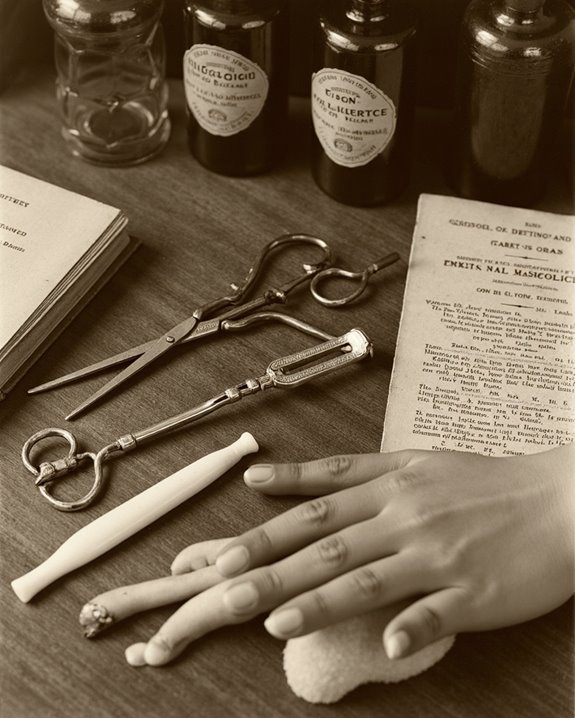
The late nineteenth century witnessed a revolutionary period in nail care history with the introduction of the first patented modern nail clippers, transforming what had been a cumbersome grooming task for millennia. The breakthrough came in 1875 when Valentine Fogerty secured the first patent for a modern nail clipper in England, establishing the foundation for an essential tool in personal grooming.
Subsequent inventors rapidly built upon this innovation, with William Edge (1876) and John Hollman (1878) refining the initial design. Most significantly, Eugene Heim and Celestin Matz patented their groundbreaking clamp-style clipper in 1881, introducing a lever mechanism that allowed for increased precision and ease of use. George Coates further contributed to these advancements in technology with his 1885 patent, cementing the nail clipper’s evolution into the familiar, indispensable tool we rely on today.
Key Patent Developments in Nail Clipper Evolution
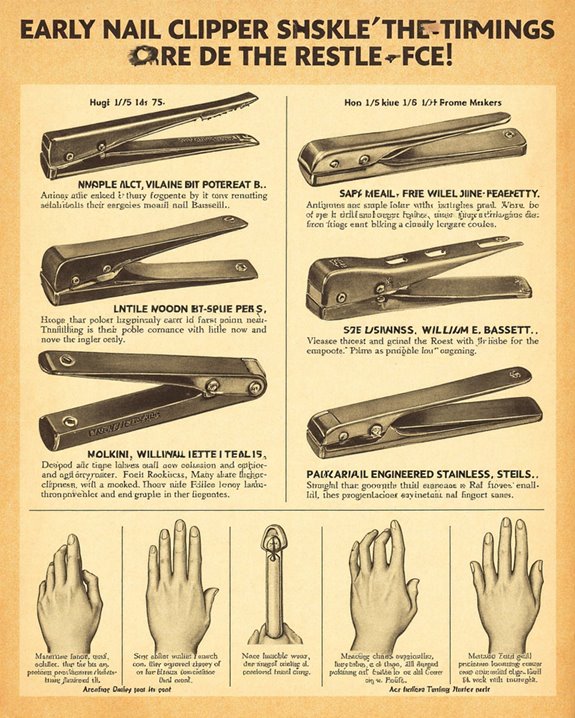
Patent developments in nail clipper technology during the late 19th century created a foundation for modern nail care that we still rely upon today. The innovation journey began in 1875 when Valentine Fogerty filed the first US patent for a lever-style design, marking the initial step in nail clipper evolution. William C. Edge followed with an improved design in 1876, enhancing functionality for everyday users.
Mass Production and Global Adoption of Nail Clippers
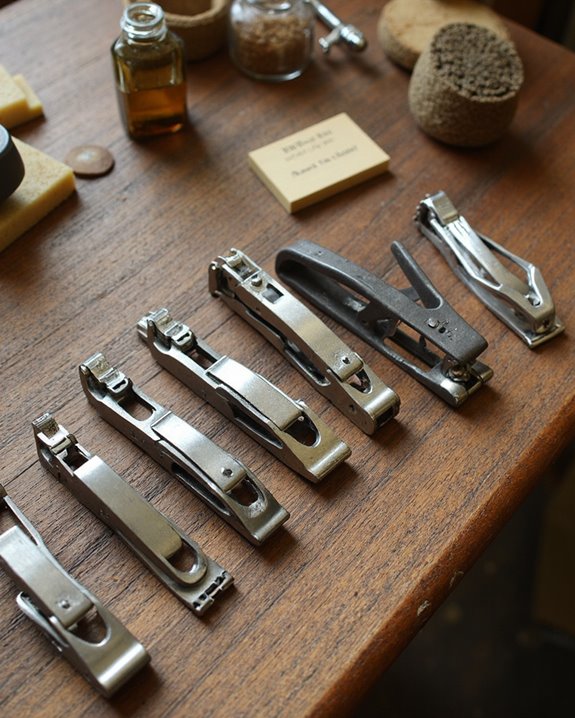
While patents laid the groundwork for nail clipper design, industrial advancement in the late 19th century sparked a manufacturing revolution that would forever change personal grooming. The New American stainless steel designs came from inventors like Eugene Heim, who influenced modern nail clipper production methods after the Gem brand’s introduction around 1896. I’ve found that manufacturing nail clippers on an industrial scale, pioneered by H.C. Cook Company in 1903, transformed these tools from luxury items to household essentials. The Boston Globe reported on this hygiene and grooming transformation as nail clippers reached global markets, becoming as common as the Swiss Army knife in personal care kits. By the early 20th century, even rotary nail clippers had entered mass production, standardizing nail care practices across cultures worldwide.
Materials and Design Features of Today’s Nail Clippers
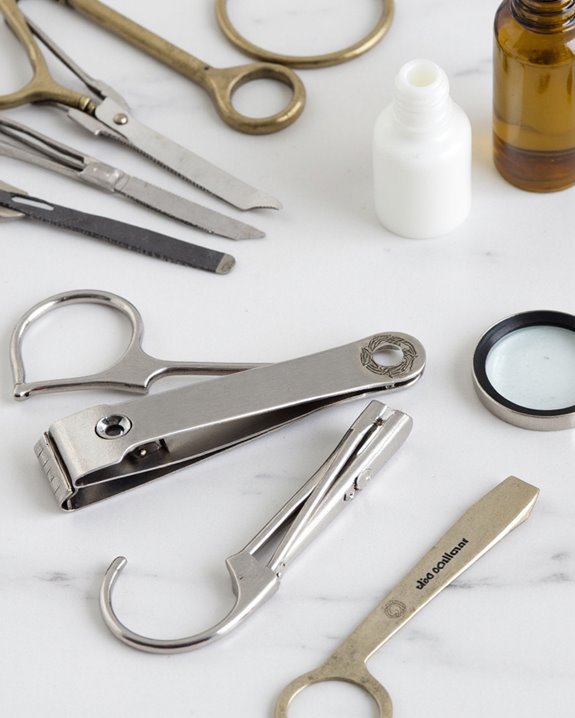
Modern nail clippers, with their sleek profiles and precision engineering, represent a significant advancement over their historical counterparts. I’ve found that today’s clipper models are primarily crafted from stainless steel, offering superior durability when you trim your nails regularly. The design of these devices often includes a compound lever system with fulcra, creating mechanical advantage that makes cutting easier, particularly with Precision Toenail Clippers for thicker nails. Most combination nail clipper sets now feature cutting heads that are specifically shaped—concave for fingernails, convex for toenails—rather than the one-size-fits-all approach common with earlier models. Additionally, many modern designs incorporate a circular nail file rather than separate tools, allowing you to smooth rough edges immediately after cutting, a practical innovation that’s become standard in quality nail care tools. Enhanced materials used in some high-end models further improve longevity and cutting precision, ensuring cleaner cuts and a longer lifespan for your tools.
Cultural Practices and Superstitions Around Nail Trimming
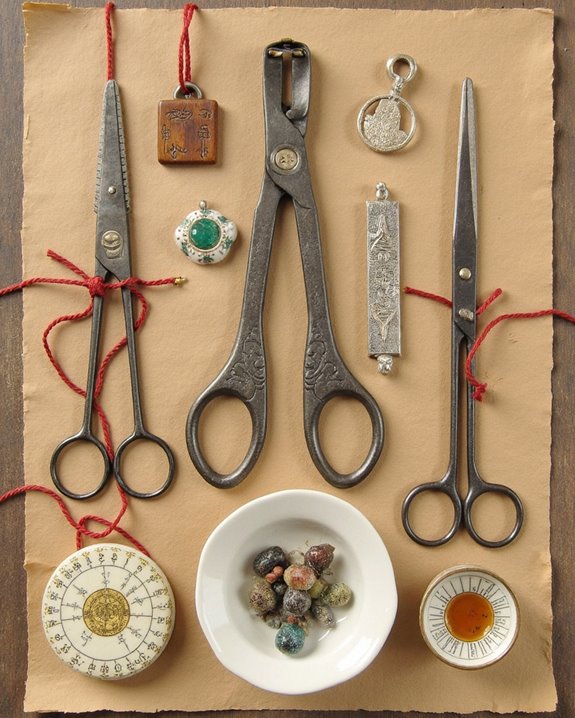
Throughout history, when and how people trim their nails hasn’t been merely a matter of convenience or hygiene, but rather a practice deeply entrenched in cultural beliefs and superstitions.
You’ll find fascinating traditions warning of bad luck if you cut nails on Friday, as it’s associated with the devil in some cultures. Similarly, trimming fingernails on Sunday might bring misfortune for the entire week, leading some to endure overgrown fingernails rather than risk these sorts of gloomy forebodings if they absentmindedly trim on inauspicious days. In China’s Ming Dynasty, long nails symbolized elite status, distinguishing nobles from manual laborers. Even ancient Roman literature contains reference to trimming fingernails, as Horace repeatedly touched upon the habit of biting fingernails out of nervousness in his Satires, showing how nail care practices have captured human attention for millennia.
Essential Nail Hygiene Techniques for Optimal Health
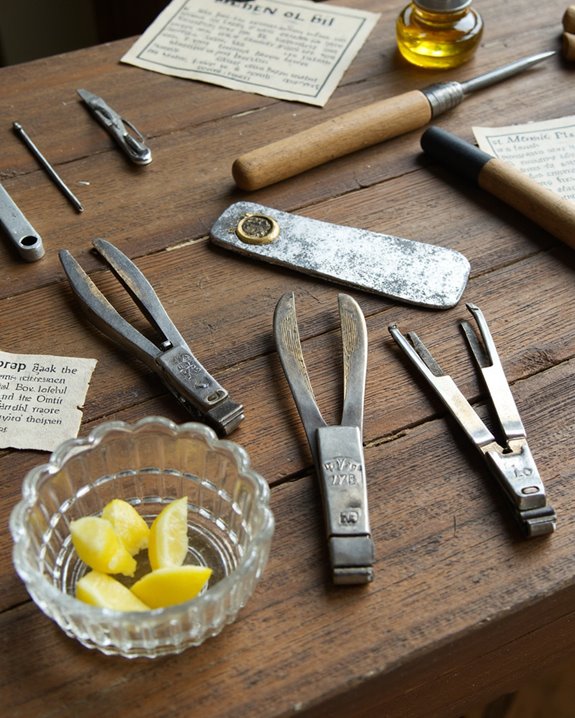
The foundation of healthy nails lies in consistent, proper hygiene practices that many of us overlook in our daily routines. I recommend filing your nails regularly with an emery board to prevent those pieces of your keratin from splitting or breaking. When I cut the finger nails, I always leave a small white tip as a reference point, which helps me trim away a bit uniformly across all digits. Treating your cuticles right means moisturizing daily and never cutting them, which prevents painful hangnails. Using fine grit nail files like 240+ ensures a polished finish without damaging the nails. Address overgrown fingernails sooner than later, as they can harbor bacteria. Precision Toenail Clippers might work better for thicker nails, while finger-nail trimmers are ideal for thinner fingernails. I suggest quietly cleaning underneath nails daily for better nail health and preventing potential infections.
Proper Nail Trimming Methods for Strength and Appearance
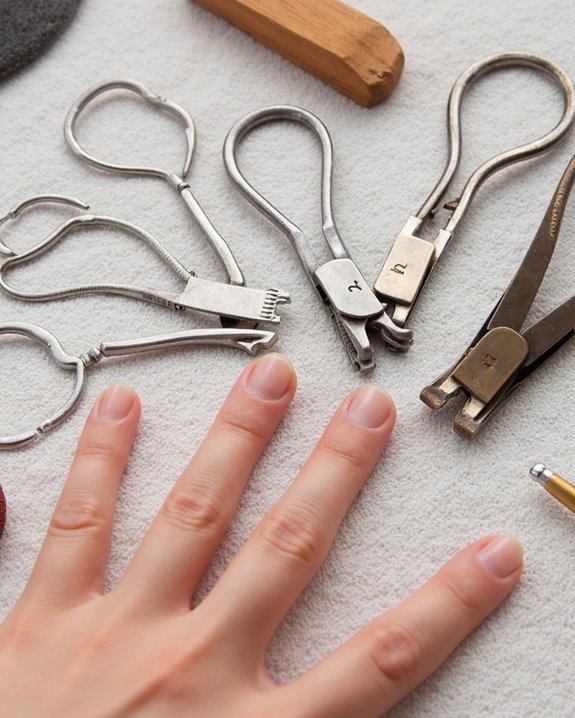
Proper nail trimming isn’t just about aesthetics; it’s a fundamental practice that directly impacts both the strength and appearance of your nails. I always recommend using an emery board in one direction as nail expert Deborah Lippmann suggests, which prevents the inconvenience of overgrown fingernails and splitting. When your toenail clippers need replacing, choose ergonomic options like Bezox Precision Clippers that come with giant handles for better grip.
Don’t absentmindedly trim away the entire white tip; instead, leave a small sliver to protect your nail bed. This isn’t just an ancient barber’s idea that white specks should remain—it genuinely strengthens nails. Use your shortest nail as a reference for others, and treat cuticles gently with moisturizer rather than paring knife to peel or cut them.
Frequently Asked Questions
How Did People Take Care of Their Nails Before Nail Clippers?
Like a gardener tending ancient vines, I’ll tell you: before clippers, humans used knives, stones, or teeth for nail hygiene and daily maintenance. Cultural practices included protective oils and herbal remedies for historical care.
How Did People Cut Their Nails in the Old Days?
I’ve studied how ancient tools varied across civilizations. From prehistoric scrapers to Egyptian practices with small blades, people used primitive methods like sharpened stones. Roman implements, early knives and indigenous ways all served before modern clippers appeared.
How Do You Clean Old Nail Clippers?
Did you know 85% of nail clippers harbor bacteria? I’d suggest an alcohol soak first, then use a brush technique with soap scrub. For rust removal, try a vinegar solution before disinfectant wipes for proper sterilization.
Do Nail Clippers Damage Nails?
Yes, nail clippers can harm nail integrity if used improperly. I’ve found that usage errors like over-cutting cause most damage. I prevent this with proper cutting techniques and tool safety to minimize clippers risks to my nails.



